MUSICAL CLOCKS: A MUSICAL SOIREE IN 18TH CENTURY ENGLAND
March 18th 2014
 Illustration of Dancers from Hogarth’s Analysis of Beauty, 1753
Illustration of Dancers from Hogarth’s Analysis of Beauty, 1753Here at Raffety Ltd we have a collection of clocks which all have a personality of their own. The majority of them strike the hours on a single bell, others have pull quarter repeat on a selection of bells. Some clocks may just be timepieces, standing in their classic cases passing the hours in elegant surroundings. If you peep a little further though you may notice something else that can also capture your imagination. It may be a bracket clock with its brass and silvered dial, pierced corner rococo spandrels and beautifully proportioned cases in mahogany, patinated walnut or even ebony. Or there are longcase clocks, standing like welcome familiars in their polished cases with swan-neck or pagoda top hoods. These clocks may look very handsome, tell the time and strike the hours but they are also famed for something else; they are musical clocks.
Musical clocks are enchanting. They epitomise the superb engineering of a clockmakers skill. They all strike the hours on a single bell but they play on up to twelve bells. If you close your eyes you can let your imagination run away with you. Perhaps you could spirit yourself back to the time of Jane Austin and Beau Brummell, taking part in a minuet at an assembly room in fashionable places like Bath and Harrogate or even Newcastle upon Tyne. These palaces of entertainment were built during the eighteenth century for supper parties, balls, card games and gentle entertainment, for the local gentry and aristocracy.
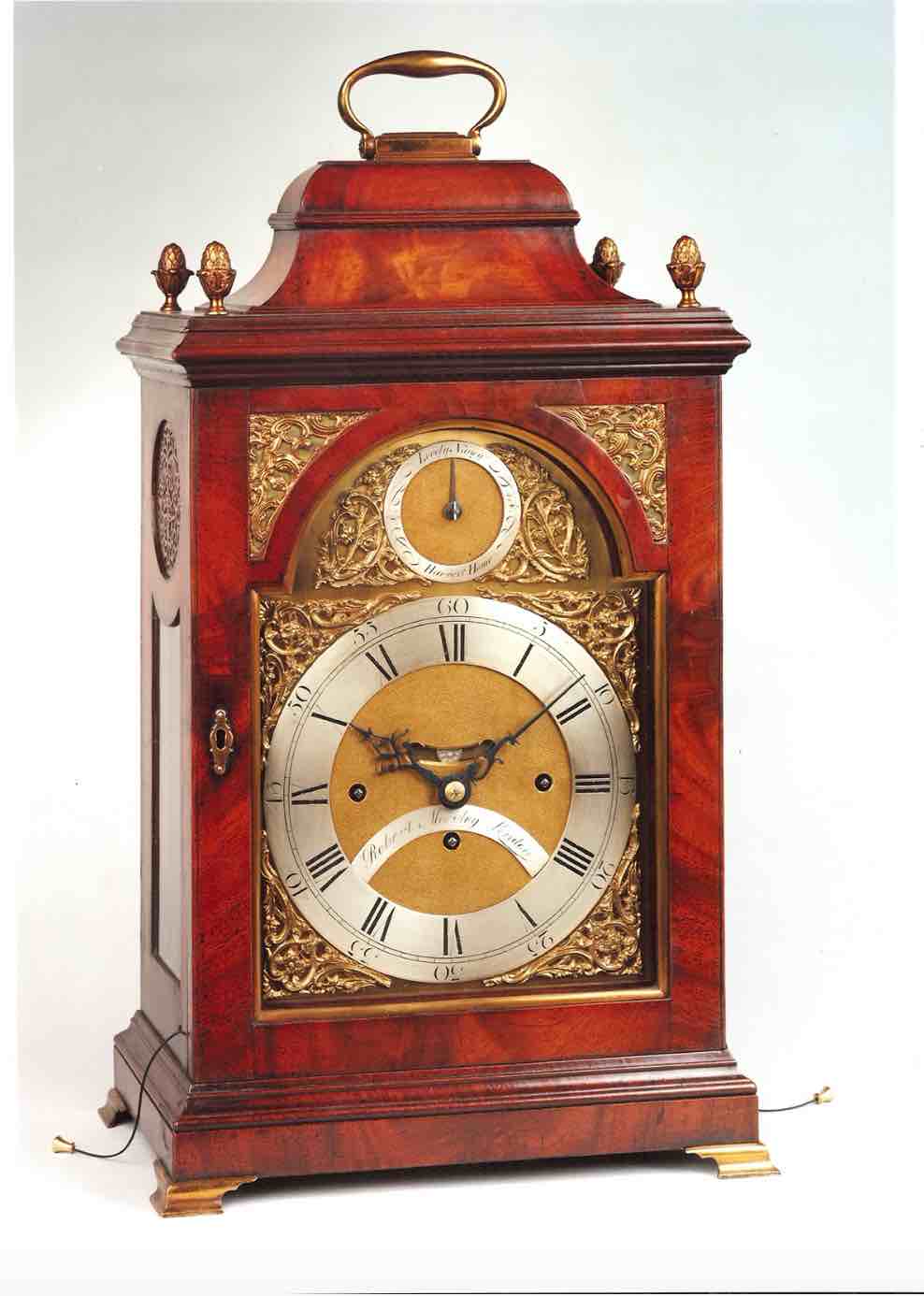
Musical Bracket Clock by Robert Manley, London. circa 1790. Raffety Ltd.
One example is a bracket clock by Robert Manley. It stands in a classic, figured mahogany case and dates from the latter part of the eighteenth century. It plays two musical tunes, ‘Harvest Home’ and ‘lovely Nancy’.
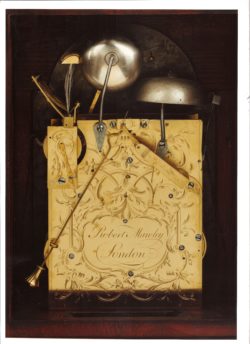
Detail of the Bells and Backplate on the Musical Clock by Robert Manley. Raffety Ltd.
To listen to the clock’s tune “Lovely Nancy”, click here http://www.youtube.com/watch?v=goI8bXrPBT0&list=UU9usCi_DjHVtycLI93Ywb3w
Another example is a little more ambitious. It is a handsome bracket clock by Robert Henderson and plays a melody of six tunes. One of the tunes may be familiar to musical lovers today as it is by Handel. ‘March in Scipio’ was written by the composer in 1725. If you attend the Trooping the Colour at Horseguards in June you will recognise the score as it is played by the Grenadier Guards and it still popular today. Another tune is ‘Suky bids me’ which was written in 1770 by William Clarke. The music quality on the Henderson bracket clock is superb chiefly because the music barrel being mounted parallel to the movement plate. Like all clocks of this calibre the back-plate is beautifully engraved with floral and rococo scrolls.
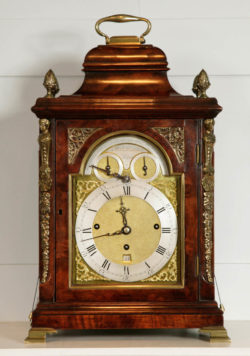
Musical Bracket Clock by Robert Henderson, circa 1770. Raffety Ltd.
The majority of these musical clocks also play a minuet. This dance was a complicated affair performed by two people. These dances were chosen to open an evening’s entertainment and you had to be pretty nimble on your toes to perform them. There must have been many varieties of minuets as these clocks have many minuets named after the leading names of the day, Miss Murray’s Minuet and Miss Fox’s Minuet being amongst them. To listen to Miss Fox’s Minuet click this link: http://www.youtube.com/watch?v=SahntT751YI
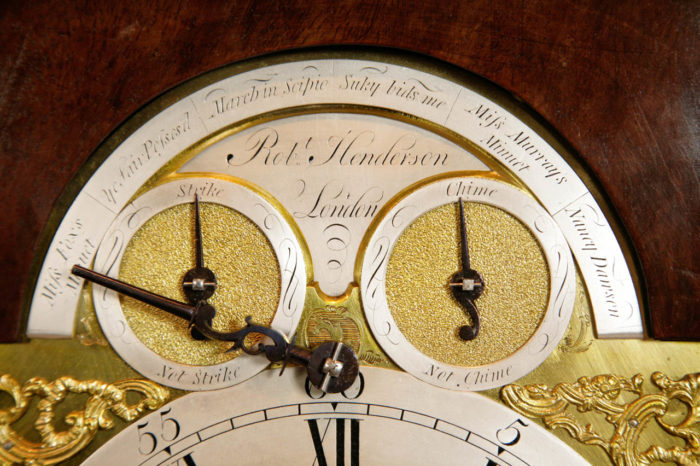
Detail of Henderson Bracket Clock. Raffety Ltd.
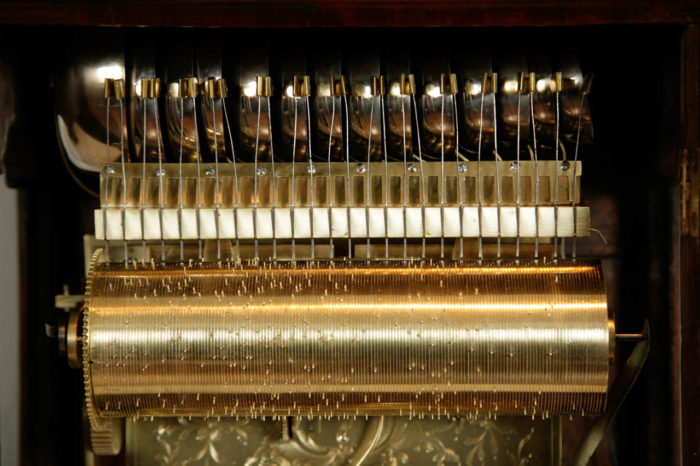 Detail of Musical Pin Barrel on the Henderson Musical Clock. Raffety Ltd.
Detail of Musical Pin Barrel on the Henderson Musical Clock. Raffety Ltd.Other artists are also represented. There is a very handsome longcase clock by Richard Collis. It is in a figured mahogany case with satinwood inlay and topped with a pagoda hood. It too plays a variety of tunes, scores which may have been very popular at the time. ‘My Lodging’ is one of them. The tune was written by the Baroque composer, Matthew Locke in the seventeenth century and at the time was a popular folk song. Another melody on the Collis is a very patriotic one; ‘Britons strike home’. It was written by Henry Purcell in 1695 and must have been well received as it was used in John Gays ‘The Beggars Opera’ in 1728.
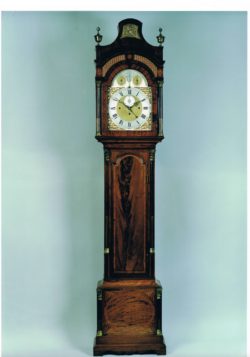
Musical Longcase clock by Richard Collis, Romford. Circa 1770. Raffety Ltd.
‘Miller of Mansfield’ is another example of Baroque music that is included on the Collis. It was written by Thomas Augustine Arne and appeared in a theatrical production at the Theatre Royal, Drury Lane in 1737. Click the link to listen to the tune: http://www.youtube.com/watch?v=Rz6dxTxDOeA
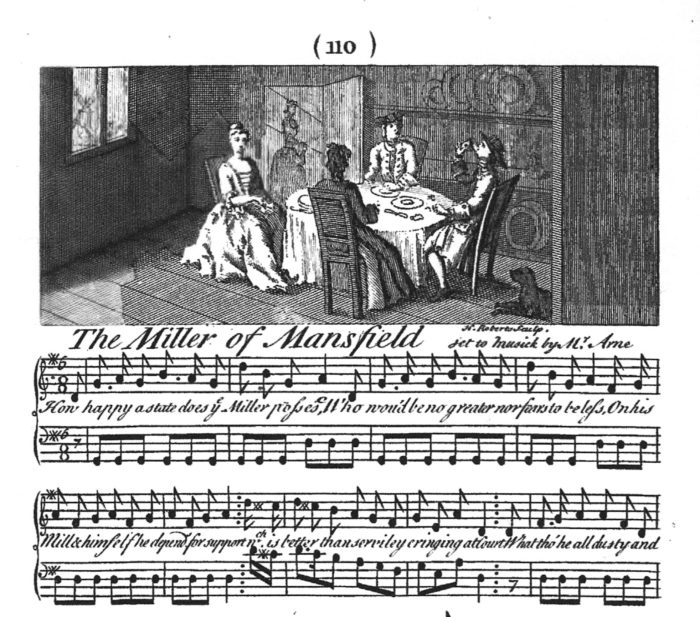 Detail of the Musical Score for the Miller of Mansfield, published in 1739.
Detail of the Musical Score for the Miller of Mansfield, published in 1739.These sparkling scores are just two of seven that adorn the Collis. Others are ‘104 Psalm’, ‘Lovely Nymph’ and’ Paties Mill’ plus marches like ‘Grand March’ which you can imagine being danced in many grand ball rooms as well as being heard on a parade ground.
 Detail of Dials on the Longcase Clock by Richard Collis. Raffety Ltd.
Detail of Dials on the Longcase Clock by Richard Collis. Raffety Ltd.The second longcase clock is by William Withers and is also musical. The clock itself is in a dark, handsome mahogany case with flame figured veneers. It has a pagoda top and the movement has three tunes. The predominant one is ‘Granbys March’. This amazing score was taken from the original slow march of the Royal Horse Artillery and was published by Thompson and Son, London, in 1760. The score was written for the Marquis of Granby who was Master General of the Regiment from 1763 to 1772.

Musical Longcase Clock by William Withers. Circa 1760. Raffety Ltd.
It is really quite incredible that these beautiful examples are not only pleasing to the eye but must have given the owners of the Georgian era a great amount of pleasure. Imagine dancing to your favourite music at an assembly room and then returning home; only to find your special score on your musical clock.
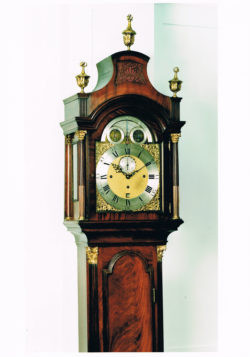
View of Musical Clock by William Withers. Raffety Ltd.
The Georgian era saw a passion for innovation when it came to luxurious objects, whether they are musical clocks, automata clocks or other great works of art, including furniture, silver and ceramics, landscape and interior design. Everything at that time depicted great craftsmanship and displayed the Georgian’s interest in the unusual and the exotic. These pieces were designed to pleasure the eye and create a statement in a grand setting; and they produced an enchantment that has cascaded down the generations to still give pleasure today.
Text by Stephen Wild and Videos by Tara Draper-Stumm
listen to Raffety Clocks on our You Tube page

